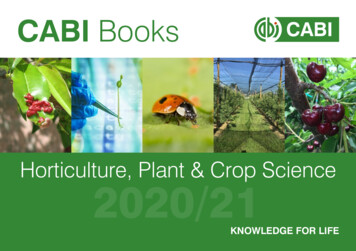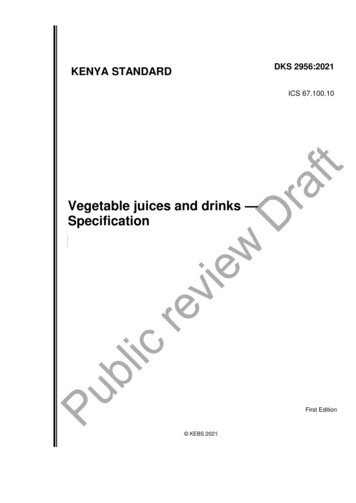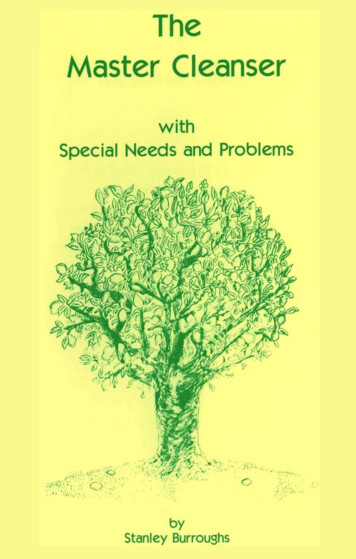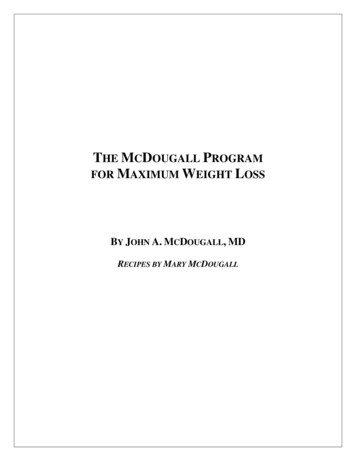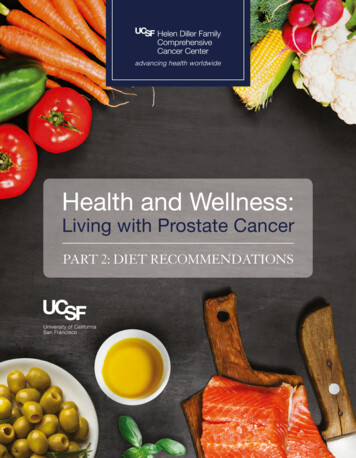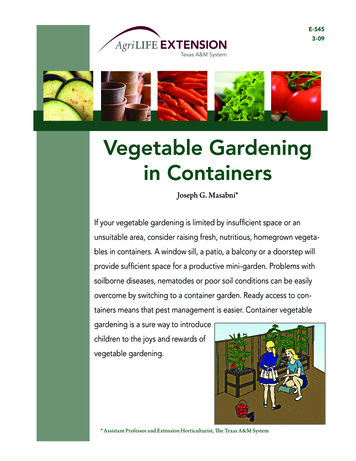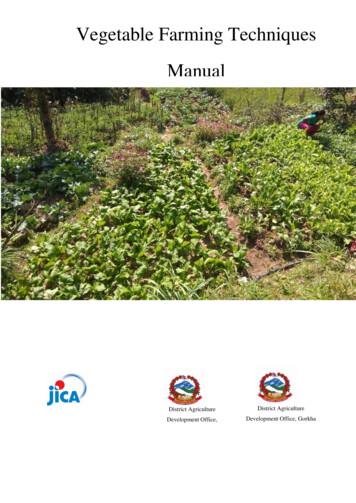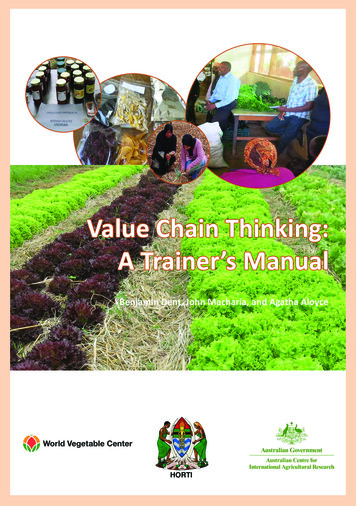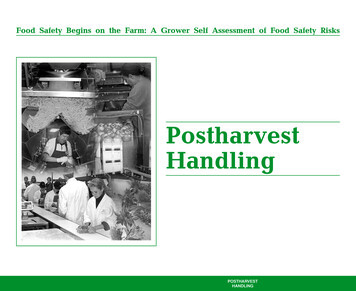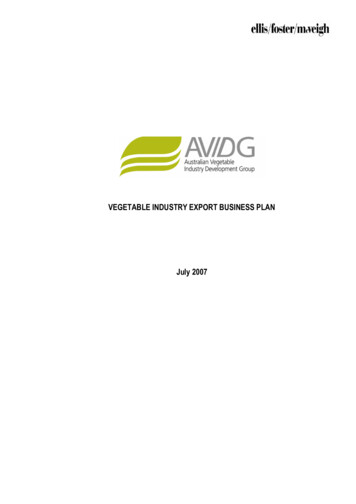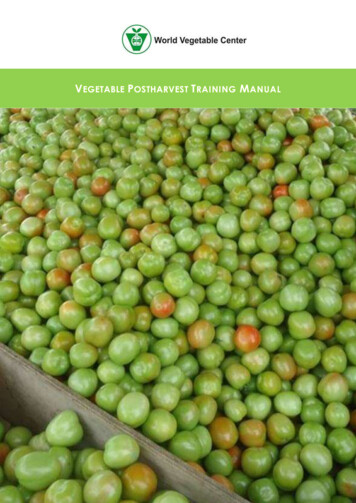
Transcription
VEGETABLE POSTHARVEST T RAINING M ANUAL0
Vegetable Postharvest Training ManualAntonio L. Acedo Jr.World Vegetable Center South Asia, IndiaMd. Atiqur Rahman(Bangladesh translation)Bangladesh Agricultural Research InstituteBorarin Buntong(Khmer translation)Royal University of Agriculture, CambodiaDurga Mani Gautam(Nepali translation)Agriculture and Forestry University, NepalJuly 2016AVRDC/USAID Postharvest Program1
Published byWorld Vegetable Center is the leading international nonprofit organization committed toalleviating poverty and malnutrition in the developing world through the increasedproduction and consumption of safe vegetables.Contact:AVRDC - The World Vegetable CenterP.O. Box 42, Shanhua, Tainan 74199TAIWANTel: 886 6 583 7801Fax: 886 6 583 0009Email: info@worldveg.orgWeb: www.avrdc.orgSuggested citation:Acedo AL Jr, Rahman MA, , Buntong B, Gautam DM. 2016. Vegetable Postharvest TrainingManual. World Vegetable Center, Taiwan. p.2
AcknowledgementThis training manual was produced under the AVRDC/USAIDPostharvest Program through the support provided by the Bureau for FoodSecurity, U.S. Agency for International Development (USAID), under the t ermsof Award No. AID-BFS-IO-12-00004. All opinions expressed in this manualare those of the authors and do not necessarily reflect the views of theUSAID.3
ContentsPageAcknowledgement3I. Introduction6-The training manual6-Scope and contents6-The training program6-Planning and preparing for the training7-Implementing the training8-Evaluating the training10II. Importance of Postharvest Management16-Reducing postharvest losses16-Postharvest losses of vegetables17-Value chain approach to reducing postharvest losses18III. Vegetable Value Chains19-Value chain19-Traditional chain19-Modern chain20Postharvest chain21IV. Vegetable Quality and Food Safety22-Quality22-Quality components22-Quality loss25-Quality monitoring26-Food safety27-Food safety assurance27-Costs associated with food safety outbreaks28-Role of growers and handlers29-Good Agricultural Practice (GAP)29-Good Hygienic Practice (GHP)31-Good Manufacturing Practice (GMP)31-Hazard Analysis Critical Control Point (HACCP)31V. Factors Affecting Vegetable Quality33-Physiological factors33-Mechanical factors37-Microbiological factors374
-Entomological factors38-Environmental factors38-Production factors39VI. Harvesting and Field Handling42-Harvest maturity42-Time of harvest43-Harvesting method44-Field handling45VII. Packhouse Operations and Packaging47-Nature and importance47-Receiving47-Sorting and grading48-Cleaning48-Treatments before packing49-Packaging51-Modified atmosphere packaging (MAP)53-Dispatch to market54VIII. Cooling and Storage55-Nature and importance55-Precooling56-Ice cooling56-Coolbot cold storage57-Evaporative cooling storage58IX. Transport and Market Handling59-Transport59-Market handling61X. Processing and Value Addition62-Importance62-Solar drying62-Paste production64-Fermentation65XI. Practical Exercises68XII. References715
I. IntroductionThe training manual Resource material for the training of trainers (TOT) programs onpostharvest management of vegetables. Source of information for the crop-specific and technologyspecific training of end-users (TEU) programs for smallholders.TEU material can be limited to the following topics: importance ofpostharvest technology and crop-specific and general informationon best practices and technologies. Platform of information that can be used to design similar trainingcourses and as reference material for research and educationunder developing country setting. References are provided as additional sources of information. It isessential to consult new information to ensure up-to-dateknowledge of latest trends and continuously adapt and improvethe training materials. Each chapter is presented concisely in bulleted form. Mostchapters are linked to practical exercises. The practical exercises, including on-site trainings, provideparticipants actual experience of the theoretical componentthereby reinforcing comprehension of the training topics. Practical exercises can be used to develop context-appropriatehands-on training packages for small farmer-learner programs. Information provided in this training manual should be shortened(telegraphic wording) and more visual images (pictures,caricatures, diagrams, etc.) should be incorporated in preparingthe powerpoint presentations for the lecture part of the TOT. Practical exercises must be carefully planned; needed materialsshould be prepared well in advance; and technological treatments(effects on fresh or processed product) for observation during thetraining should be set up at appropriate time before the training.Scope and contents Postharvest: fresh produce handling and processing6
Postharvest management: best practices and simple, low-costtechnologies and innovations to reduce losses, enhance qualityand food safety, and improve profitability of a farm enterprise. Value chain approach: from production to consumption, includingvarieties with desired postharvest traits, farm factors, harvesting,packinghouse operations, packaging, storage, transport,processing/value addition, handling in markets and at home Vegetables covered:Global vegetables: tomato ( Solanum lycopersicun ) and chilipepper ( Capsicum sp. )Traditional vegetables: eggplant ( Solanum melongena ),cauliflower ( Brassica oleracea var botrytis ), cabbage (roundcabbage or head cabbage) ( Brassica oleracea var capitata ),Chinese kale ( Brassica oleracea var. alboglabra ), mustardgreens ( Brassica juncea var. rugosa )The training program The training provides participants with knowledge and experience inmanaging vegetable value chains and integrating postharvesttechnologies and best practices to reduce product losses, enhanceproduce quality and safety, and improve value chain efficiency. The training has a balance of theoretical and practical (on-sitetraining/exposure visits and hands-on exercises) aspects. It could betailored to client’s requirement. To draw optimum benefit from the training, it is essential to study thetraining manual and the application of the practical examples to futuretraining programmes in a different context (country, region, crops,target audience, etc.). In preparing training materials, the literacy level, language andknowledge base of target audience must be taken into account. TOT is designed to produce effective teachers of technology users.Future trainers should be able to work within the time and budgetresource and to mobilize resources. This is introduced in the TEUmaster plan workshop of the TOT.Planning and preparing for the training A well-planned training course is the basis of effective informationtransfer. It should integrate in a balanced manner the dimensions of7
academic excellence, hands-on experience, tasks, discussion sessions,excursions, formal lectures and a social dimension to allow forinteraction and knowledge sharing. Physical facilities such as the training venue should create anenvironment conducive to learning but should also incorporateconsiderations for possible shortcomings of facilities and other issues. Planning a training program must consider the basic principles of adultlearning, incorporating adequate breaks for reflection, discussionsessions to stimulate thought and to challenge participants, andpractical exercises that relate to the lectures. Trainers must have some knowledge of the background of theparticipants and their expectations. This can be done through a simpleanalysis, using a basic needs assessment form. The complexity of theform will depend on the composition of the group of trainees. Insituations where the trainees make up a diverse audience (for example,a mix of exporters, transporters, government officials etc.) a form suchas that shown in Figure I can be used.Implementing the training Every effort must be made to ensure successful knowledge transferduring implementation of a training program. Attention must be givento details that can impact on the flow and quality of the program. Development of basic planning schedule can ensure that details arecovered and any last minute changes and rushing around are avoided. When preparing for lectures, it is essential that visual materials beselected according to the needs of the training group. The minimumrule of thumb of one slide a minute should be used. For a 30-minutelecture, for example the speaker should ideally select 30 slides, butmight be able to go comfortably up to 45. It is essential to understand the trainees’ situation, create a caring andconcerned environment, use a variety of instructional methods suitablefor the audience, exhibit enthusiasm and passion for the task, anddevelop a positive and participatory approach within the group. Visual images are remembered more effectively than words andtrainees prefer ‘How to’ and ‘Hands-on’ exercises. Trainees learnbetter and faster when given opportunities to apply, explain andpractice what they have learned or when working in groups.8
Figure 1 Sample form for assessing training requirements of a diverse audience.WHAT ARE YOUR EXPECTATIONS OF THE COURSE?Please complete the form and answer all questionsFull name and surnames: .Job title: .Company/institution that you work for: Contact details, e-mail: .Tel no: country code Area code . Number . Fields of specialisation: (tick all applicable):Horticulture Post-harvest technology Post-harvest pathology Microbiology . Post-harvest physiology . Agricultural economics .Education Others Fields of formal qualification:Horticulture Post-harvest technology Post-harvest pathology Microbiology . Post-harvest physiology . Agricultural economics .Education Others .In which of these fields do you currently work?Horticulture Post-harvest technology Post-harvest pathology Microbiology . Post-harvest physiology . Agricultural economics .Education Others . What is your highest qualification? .General questions:Do you use your e-mail regularly? Yes . No . If yes, how often? .Does your company have a website? Yes No If yes, have you visited it? Yes . No . What are your expectations of this training course? . . What do you plan to do with this information once you return to your respective country? . Are you involved in training? Yes No . If yes, for whom? What is the trainees’ level of education? How many attend at a time? How often do you train people per year? Do you enjoy it? Yes Not really Would you like to see more practicals in a training programme? Yes . No .Why? .What kind of practicals? What level do you think this course is going to be? . Do you think you need a test at the end? Yes No . If yes, why? . How would you like to be measured in terms of absorbing the knowledge? Any suggestions for the trainer in terms of your expectations? 9
Evaluating the training Training evaluation helps to continuously improve training delivery andoutcome/impact. It gives trainees an opportunity to question and to beaware of what they have learned. It also gives them confidence to applythe skills they have acquired and helps them analyze the way in which theyhave acquired knowledge. Feedback could be obtained through the use of assessment forms to ratepresenters, the material presented by them, the content of theirpresentations, and the level of confidence with which they presented thematerial. A sample training evaluation instrument is given in Figure 2. Credit can be given for group discussion during the programme andindividual participation may be acknowledged at the end of the workshop.Awarding tokens for the best participant, most vocal individual, funniestperson etc. is always fun and makes the workshop memorable. The training can be concluded with a test or puzzle to determine the levelof effective uptake. Tasks may be given and a time frame to complete thetasks could be an alternative way of assessing the knowledge uptake ofparticipants. For trainees who are technology end-users (e.g. smallfarmers and other value chain actors), an assessment form to be filled upby them right after the training (Figure 3) and after 6-12 months later(Figure 4) can measure technology uptake. A basic databank should be developed and maintained to record the date,venue, type of training offered, number of trainees attending, theirpersonal contact details and whether they have successfully completed thecourse. Keeping a databank of training programmes held can aid in theefficient logistical management of events.10
Figure 2 Sample training assessment form.Training EvaluationCountry or Name (optional):Aspect to evaluateDate:54excellent Very good3Good2Fair1Poor1. Resource personsPreparednessCommunication skillsEffectiveness in presenting the topic usingavailable toolsExperience in the fieldAbility to retain the concentration of the groupAbility to stimulate discussions and interactionAbility to create a stimulating environment2. Lecture materialsAdequacy/sufficiency for the topicComprehensiveness of the contentStructure of the presentationVariations in the presentationEffectiveness in bringing the message andconcepts across3. Practical exercises/field visitsRelevance to the topicAdequacy/sufficiency for the topicOrganization/structure of hands-on activitiesUsefulness in enriching the lecture4. Overall training courseOrganization of the trainingAdequacy/sufficiency of training facilitiesEffectiveness as a ‘train the trainer’ coursePractical application of the courseDid the training meet your expectations5. Other impressions – please write down other feedback not covered above:5.1. Other strong points of the training:5.2. Other weak points of the training:11
Figure 3 Sample evaluation form right after the training of end-users.AVRDC/USAID Postharvest Project’s Technology Promotion ActivityEVALUATION RIGHT AFTER THE ACTIVITY1. Name of activity:2. Date and place of activity:3. Co-sponsor/co-organizer (in addition to AVRDC):Participant’s information:1. Name: 2. Age: 3. Gender: 4. Family size:2. Address:3. Phone/Cellphone number:4. Classify yourself (one or more) by ticking appropriate box: 1 Input supplier 2 Farmer 3Trader/marketer 4 Processor 5 Consumer 6 Government employee 7 University employee 8NGO employee 9 Private enterprise 10 Others (please specify):5. Main source of income: 6. Average monthly income:6. Farm area (please specify unit):Total farm area:Vegetable farm area:Tomato farm area:ndFarm area of 2 crop (Bangladesh-brinjal; Cambodia-leaf mustard; Nepal-cauliflower):7. Do you plan to increase the area for vegetables in the next year (Y/N): ; if yes, specifyexpansion area:Vegetable farm area:Tomato farm area:ndFarm area of 2 crop (Bangladesh-brinjal; Cambodia-leaf mustard; Nepalcauliflower):8. Are you a member of a group or association (Y/N)? ; if yes, classify and give the name: 1 Private enterprise (for profit): 2 Farmers/Processors/Producers group: 3 Water users association: 4 Women's group: 5 Trade and business association: 6 Community based organization (CBO): 7 Others (specify):Overall assessment of the technology promotion activity: 5 Excellent – excellent delivery, more practical activities (including hands-on anddemonstration of techniques); all knowledge and techniques were new. 4 Very good – very good delivery, more practical activities; more than 50% of theknowledge and techniques taught were new. 3 Good – good delivery with more practical activities but less than 50% of the knowledgeand techniques taught were new. 2 Fair – more lecture than practical activities; less than 50% of the knowledge andtechniques taught were new. 1 Poor – only lecture, no practical activities; all knowledge and techniques taught werenot new.Other comments about the activity:12
Knowledge uptake right after the technology promotion activity:1. Did you know anything about postharvest technology/best practics before this activity (Y/N)?If yes, please specify this postharvest knowledge:2. Did you learn anything new from this activity (Y/N)? ;If yes, what new knowledge did you gain (tick appropriate box and specify if possible): 1Harvesting: 2 Field handling: 3 Packinghouse operations (e.g. sorting, cleaning, etc.): 4 Packaging: 5 Storage: 6 Market handling: 7 Processing: 8 Others (specify):3. Will you adopt the technologies and best practices you learned from this activity (Y/N)?If yes, which knowledge you will adopt: 1 All 2 Some (specify)4. Can you share the knowledge to others in the next six months (Y/N)?If yes, how many persons below to whom you will share the knowledge and what is their farmarea?CategoryNumber ofFarm area (specify unit)ndpersonsAll vegetablesTomato2 priority crop/country (specify)Input supplierFarmersProcessorsMarketers (collectors,wholesalers, retailers)Private enterprise/business operatorsOthers (specify)13
Figure 4 Sample evaluation form after 6-12 months from training of end-users.AVRDC/USAID Postharvest Project’s Technology Promotion ActivityEVALUATION AFTER 6-12 MONTHS FROM CONDUCTING THE ACTIVITYOur record shows that you participated in the following technology promotion activity and we would like toknow about how you used the knowledge and skills gained from this activity and their outcomes.1. Name of participant (other information in previous form):2. Name of activity:3. Date and place of ---------------------------------- -----Use of postharvest knowledge (technologies and/or best practices)1. Did you use the postharvest knowledge you gained from the past training (Y/N)?2. If no, what is/are the reason/s?3. If yes, what postharvest knowledge did you adopt? (tick appropriate box and specify): 1 Harvesting: 2 Field handling: 3 Packinghouse operations (e.g. sorting, cleaning, etc.): 4 Packaging: 5 Storage: 6 Market handling: 7 Processing: 8 Others (specify):4. Will you continue to use the postharvest knowledge (Y/N)?5. What is the reason for continuing (Y) or not continuing (N) using the postharvest knowledge?Effects of using the postharvest knowledge (technologies and/or best practices)1. What happened when you used the postharvest knowledge? (tick one or more) 1 Reduced postharvest losses 2 Increased income 3 Higher price of produce 4 Better product quality & shelf life 5 More markets/buyers 6 Easy to sell produce 7 Increased the production (for farmers), product volume for marketing (for marketers) orproduct volume for processing (for processors) 8 Others (specify)2. In relation to your answer/s in no. 1 (reduced losses, increased income, increased price, and/orincreased production or marketing volume), provide the necessary information in the followingtable:VC actor/CropPostharvest loss(specify unit)Production area Prodn, marketing or Frequency of prodn,(for farmers)processing volumemarketing orper cycle (spec unit) processing per yearBeforeAfterBeforeAfterBeforeAfterBeforeAfterA. FarmersTomatoBrinjal, mustard, cauliflower(encircle county 2nd crop)All vegetablesB. Marketers (specify whether collectors, wholesalers, retailers)TomatoBrinjal, mustard, cauliflower(encircle county 2nd crop)All vegetablesC. ProcessorsTomatoBrinjal, mustard,cauliflower (encircle county2nd crop)All vegetables‘Before’ means before attending the technology promotion activity; ‘After’ means after attending such activity.Postharvest loss can be answered as volume loss per pack; percent loss and total loss can be computed later.Frequency of marketing can be per week and then calculated to per month or year.Unit price ofproduce (specifyunit)BeforeAfter14
3. Did you share the postharvest knowledge to others (Y/N)?If Yes, complete the following table:Type of VC actor to whomknowledge was sharedNo. ofAreaAre they group or assn. members?*Did they use the postharvestpersons planted toknowledge?vegetables Yes/No Name of group or assn. Yes/No If Yes, what happened?** 1 Input supplier 2 Farmer/farm household 3Marketer (collectors,wholesalers or retailers) 4 Processor 5 Consumer 6 Government employee 7 University employee 8 NGO employee 9 Private enterprise person 10 Other (specify):*Group or association includes Private enterprise (for profit); Producers organization; Water users association; Women'sgroup; Trade and business associations; Community based organization (CBO); Farmer's group; Consumer's association;and others (specify)**Possible effects are the same as in no. 1.4. If you have increased your income as a result of the application of the postharvest knowledge,what did it bring to your life? (tick one or more) 1 Acquire more assets (specify the assets) 2 Open new business (specify the business) 3 Sent children to school 4 Save more money in the bank 5 Life is easier financially than before 6 Others (specify)15
II. Importance of Postharvest ManagementReducing postharvest losses A global agenda under the United Nations SustainableDevelopment Goal (SDG) 12.3 which targets 50% reduction of percapita global food waste at the retail and consumer levels andfood losses along production and supply chains, includingpostharvest losses by 2030. SDG 12.3 recognizes that about one-third of food produced forhuman consumption is lost or wasted globally, which amounts toabout 1.3 billion tons of food per year worth nearly USD onetrillion. These losses account for about one-fourth of water usedin agriculture, total cropland area, and total fertilizer use, andproduce about 3.3 billion tons of CO 2 emissions yearly. In developing countries, about 65% of lost food occurs at theproduction, processing and postharvest stages. Reducing food loss and waste can save money for farmers,businesses, and households; can feed more people; and canalleviate pressure on climate, water, and land resources. Specifically, postharvest loss reduction can:-Increase market share and competitiveness of smallholders-Stimulate growth of agribusiness industries, such as inputsuppliers (e.g. packaging, processing ingredient) and logisticsproviders (e.g. transport, storage).-Generate more employment and income opportunities andstimulate the rural economy.-Promote gender equality asmore women are involved inpostharvest and marketing operations. Improve human nutrition and healthVegetables are high income and nutritious food crops. Reducingpostharvest losses reduces poverty and food insecurity. Cross-cutting strategies to reduce food losses include:-Developing loss measurement protocol-Setting loss reduction targets1616
-Increasing investment in loss reduction in developing countries-Supporting collaborative initiatives to reduce lossesPostharvest losses of vegetables Postharvest losses of vegetables are serious in developingcountries due to lack of knowledge, techniques, and facilities forproduce handling and processing and poor marketing systems.The corresponding loss of food and economic opportunitiescontributes to poverty, food insecurity and malnutrition, whichmostly affect smallholders who dominate vegetable industries. Lack of postharvest options has led to total loss of production. Postharvest loss is usually absorbed by farmers as reduced farmgate price and consumers as increased purchase price. Postharvest losses vary with crop, location, production season,value chain, and value chain actor. For the major vegetables (tomato, eggplant, leaf mustard andcauliflower) in Bangladesh, Cambodia and Nepal, postharvestlosses range from 19-35% of production (Figure 5). AVRDC alsoassessed earlier vegetable losses in three Southeast Asiancountries and found an average loss of about 17% equivalent to1.5 million metric tons worth USD 461 million annually (Figure 6).Figure 5 Postharvest losses of vegetables in Bangladesh, Cambodia and Nepal.35%26%25%Postharvest losses 27%Bangladesh23%Cambodia19% Due to handling, packagingand storage deficienciesValue chain actors notexposed to postharvesttechnologiesNepalFigure 6 Postharvest losses of major vegetables in Cambodia, Laos and Vietnam.1717
Unseen losses are the loss of nutrients (e.g. vitamin C) andwholesomeness (e.g. pathogenic microbes and pesticide residues). Loss of vitamin C, which is usually used as nutritional indicator,may range from 27-100% depending on the conditions during thepostharvest period. Loss of B vitamins, particularly thiamin and B6,varies from 7-70%. Carotenoids and fiber are relatively stable. Faulty postharvest practices, such as poor hygiene and use ofcontaminated wash water, provide opportunities for contaminationby toxin-producing and pathogenic microorganisms. Food safety is a global issue and compliance to food safetyassurance systems (e.g. GAP, GMP and HACCP) is a prerequisite toaccess high-value export markets.Value chain approach to reducing postharvest losses This ensures real needs and problems are addressed andinterventions fit into the system. In general, the approach has three components (Figure 7).-Value chain analysis – losses are assessed and the needsand priorities for intervention are determined.-Technology generation – adaptive research optimizes andsuits available technologies to local condition. Research todevelop new technologies can also be conducted.-Building capacities – technological and non-technologicalinterventions are introduced to capacitate value chain actorsfor better control of quality and volume of produce and formore competitive marketing. These may include trainingprograms, workshops, exposure visits, linking to markets,input suppliers and finance, and technical backstopping.Figure 7 Value chain approach to reducing postharvest losses.Value sQuantify losses;determine needs andopportunities forinterventionAdapt availabletechnologies to localsituation; developnew technologiesIntroduce technologicaland organizationalinterventions1818
III. Vegetable Value ChainsValue chain Chain of activities from input supply (seed, fertilizer, chemicals)through production, postharvest operations, distribution, and retail. Value chains vary considerably in length and complexity, depending ondistance between the producer and the target market.Traditional chain Traditional value chains are long and complex, involving severalintermediaries with high transaction costs. Figure 8 shows a typicaltraditional chain for vegetables prevalent in developing countries.There are other more complex chains when vegetables are broughtfrom one province to another involving another set of intermediaries.Figure 8 Typical traditional chain for vegetables.GrowerMiddlemanRetail MarketWholesale MarketSupermarketConsumer Traditional chains are largely supply driven with little coordination.They are a low technology system usually with no temperature controland rely on selling the produce within one day after harvest. Losses ofproduce could be very high particularly under adverse climate. Traditional chains may involve both informal and formal rural andurban markets. Produce is moved from rural to urban areas through achain of intermediaries such as assemblers and wholesalers supplying1919
produce to urban markets and commission brokers acting on behalf oflarge, long-distance traders. Wholesale and semi-wholesale markets are located within or near tomajor urban centers and may be supplied by purchasing/assemblycentres in rural areas or directly from farms, particularly those in periurban areas. Produce is supplied either by agents, traders or byfarmers themselves.Modern chain This is usually well coordinated and driven by consumer requirements.They evolved with the proliferation of supermarkets/hypermarkets andincrease in trans-national/crossborder trade. Figures 9 shows a typical modern value chain.Figure 9 Typical modern value chains.ProducersCollection center/satellite packhouseCentral distribution centeror central packhouseSupermarket chainExportConsumers Farmers are contracted with guaranteed price. Depending on the crop,the harvested produce is sorted and packed on farm and brought tothe collection center (satellite packhouse) for quality checking, sorting,treatment, packing, pre-cooling, and cold storage. Small refrigeratedtrucks collect and bring the produce to the central where produce isprocessed and packed to a high standard of efficiency and hygiene.Low grade or excess produce is usually sent for food processing. Thepacked produce is transported to supermarkets in refrigerated trucksor in refrigerated container vans for export shipment. If distribution2020
cannot be done on the same day of arrival, storage is done in a centralcold room. The cold chain system is operational in both cases. Export chains of vegetables vary with degree of vertical coordination.Vertically-integrated exporters are exporters who grow produce ontheir own farms, arrange shipping to overseas destinations and evendistribute the goods to supermarkets and wholesalers in foreignmarkets. Other groups of exporters are those who consolidate producefrom contract growers directly and those who consolidate produceprocured by brokers who in turn consolidate produce from farmers inspot market transactions or through farmer groups.Postharvest chain Postharvest activities are conducted starting at the farm (harvestingand field handling), packhouse or processing plant, and duringtransport and marketing (Figure 10). These are separately described inlater topics
- Value chain approach to reducing postharvest losses 18 III. Vegetable Value Chains 19 - Value chain 19 - Traditional chain 19 - Modern chain 20 Postharvest chain 21 IV. . For trainees who are technology end-users (e.g. small farmers and other value chain actors), an assessment form to be filled up by them right after the training (Figure 3 .
